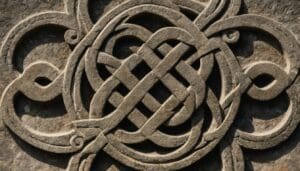13 Top Places To Visit In Beautiful Athens
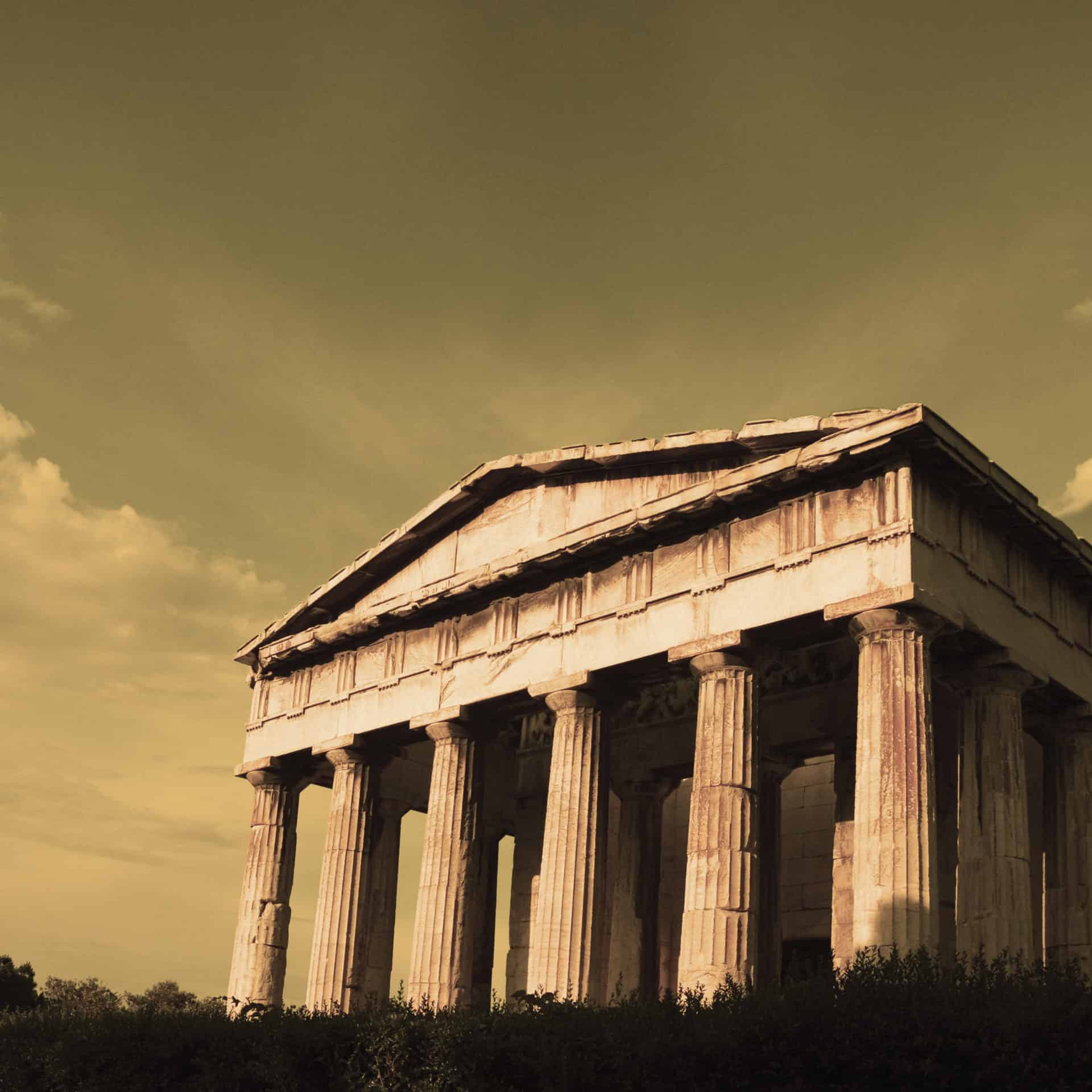
Updated On: April 16, 2024 by Esraa Mahmoud
Whenever someone says the ancient world, we immediately think of Greece; the county is arguably the symbol of antiquity, with a rich history dating back to 3000 years.
Living up to the country’s reputation, Greece’s capital Athens flourished during the times of great philosophers such as Pericles, Socrates, and Aristotle. Today, the city offers its visitors a unique experience that you won’t find anywhere else. The ancient world and the modern one come together in Athens.
In Athens, you will be spoiled with many choices when it comes to activities because the capital of Greece leaves nothing to be desired: Big city feeling and the beach right outside, good food and endless shopping opportunities, museums, history, and myths…. What more would we want!
It is no wonder that the city is a great magnet for tourists. In Athens, one sight follows the next – no sightseeing tour will be boring here! From its east to its west, here are the top things to do and see in Athens.
1-The Acropolis of Athens…. The Landmark!
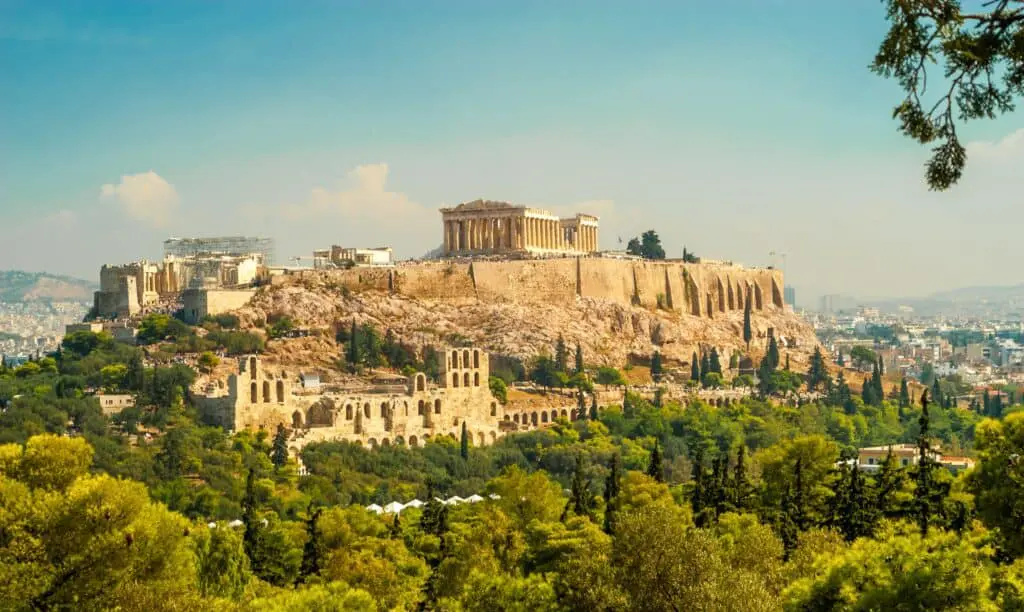
If you are in the Greek metropolis for the first time, the Acropolis of Athens is your first port of call when it comes to sightseeing in the city. There are a few things in the world that can be compared to the Acropolis of Athens.
Considered as the landmark of Athens, the Acropolis of Athens is one of the most important ancient archaeological sites in Greece. It was built between 464 and 406 BC, and its name is derived from the Greek word akro, which means “high.”
The complex of Acropolis includes important buildings such as the Parthenon, the Erechtheion, the Temple of Athena Nike-nope not that Nike- and the Propylaea. In the Parthenon, you will see a huge temple made of marble that was dedicated to the goddess Athena.
On the north side of the complex, there is the iconic temple Erechtheion that was dedicated to the gods Athena and Poseidon. There is also the Temple of Athena Nike, which was dedicated to the goddesses Athena and Nike.
As for the Propylaea, this one forms the remarkable gate to the Acropolis. The gate was built between 437 and 432 B.C. The Acropolis of Athens has been a UNESCO World Heritage Site since 1986.
Over 3 million people a year visit the complex. With all the buildings that exist today only as ruins, the Acropolis of Athens still towers over Athens reserving its place on the top of the list of best things to see in the city.
We recommend going there in the morning hours if possible. Otherwise, you will have to push your way through crowds of people and also it gets really hot at noon.
2-Dionysos Theater
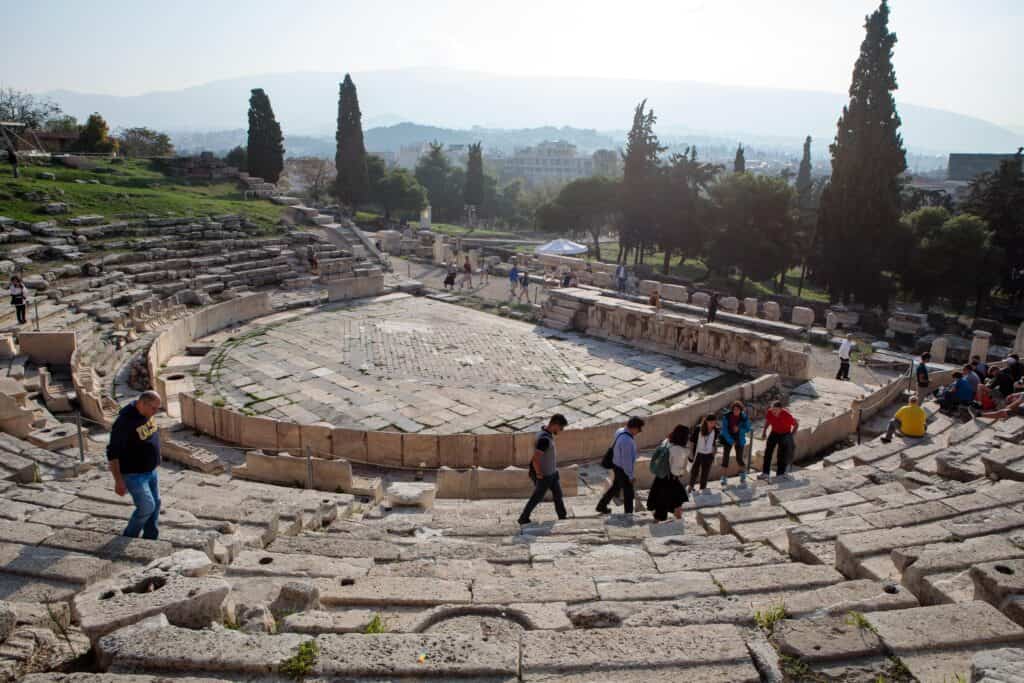
All theater fans must pay a visit to the glorious Dionysus in Athens. Resting on the southern slope of the Acropolis, Dionysos Theater is considered the birthplace of Greek tragedy.
Regarded by many as the most important theater in Greece, Dionysos Theater is the perfect place to immerse yourself in the beginnings and history of drama.
The theater was named after Dionysus, God of wine, ecstasy, joy, and madness. In his honor, a great theatrical festival was held every year. The festival featured performances of plays, song and dance performances, and plenty of other forms of entertainment.
The Dionysus Theater dates back to the 5th century B.C. and initially served as a sacred building. Today you can only see the ruins of the theater, which in earlier times was also the scene of bloody gladiator fights.
Make sure to visit the Dionysus Theater and see the place where dramas of the ancient authors Aeschylus, Euripides, and Sophocles were first performed……How amazing is that!
3-Odeon of Herodes Atticus
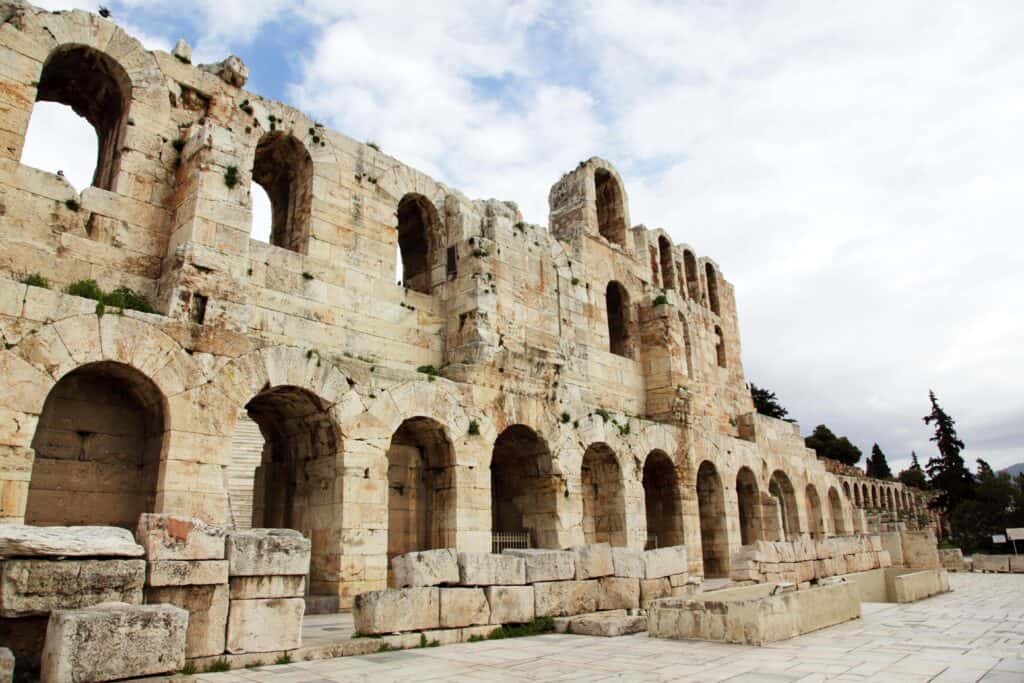
Another must-visit theater while in the city is the Odeon of Herodes Atticus. The ancient theater is located at the foot of the Acropolis of Athens, and it is considered to be the oldest odeon in the world.
An odeon is a building that was built in ancient times for musical events and other performances. And even today, music events are held regularly in the ancient theater.
Today, the Odeon of Herodes Atticus is the venue of the annual arts festival Athens Festival, AKA the Athens – Epidaurus Festival. The Odeon was donated by Herodes Atticus in memory of his wife, Regilla.
Herodes Atticus was a Greek aristocrat and Roman senator who financed several public buildings in Athens. In 161 AD, he had the Odeon built on the southern slope of the Acropolis of Athens.
It has 32 rows of seats and can accommodate 5000 people, and is built similarly to Roman theaters, with a semicircular orchestra.
One of the top things to do while in Athens is to attend a music concert or theater performance at the Odeon of Herodes Atticus. It is such an amazing experience!
4- Ancient Athens in Agora
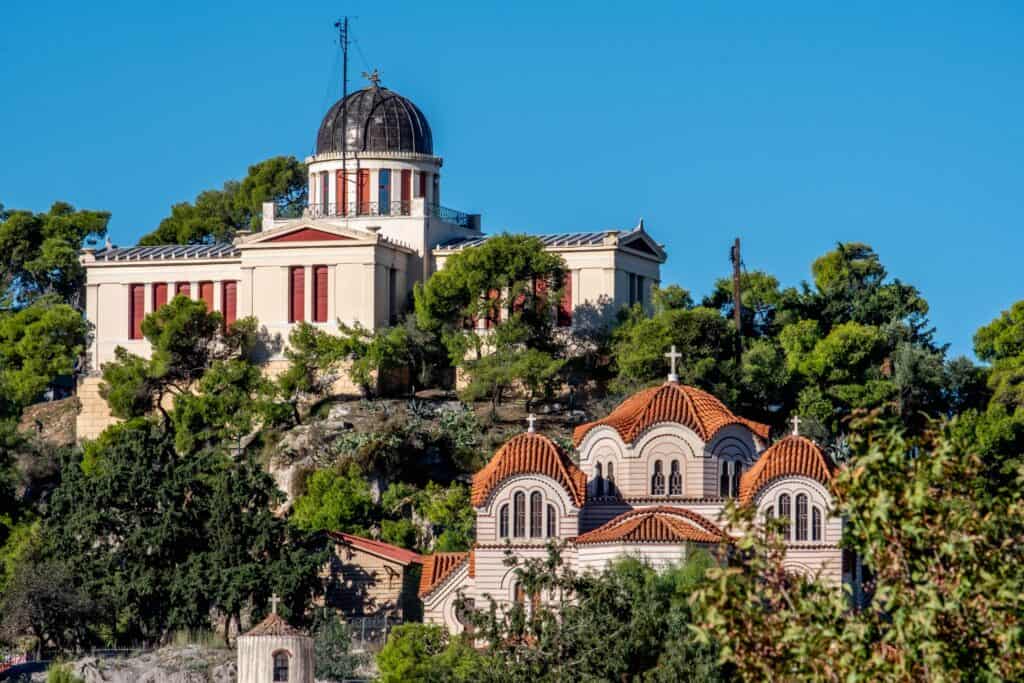
Not far from the Acropolis of Athens and the Philapappo Hill, respectively, is the Ancient Agora – not to be confused with the Roman Agora, which is very close by. The entire public life of the Athenians in ancient times took place on this 2500-year-old marketplace.
This was the marketplace and the center of everyday life in ancient Athens. From the north wall of the Acropolis of Athens or on the streets of Areopagus, you have a great view of the area. The best way to enter the Agora is from the North Gate on Adrianou Street.
Agora is a great place for history lovers, not only because in ancient times, this is where local groups met to make important decisions about the city, but also the square used to host numerous events such as theater performances.
Once the Agora housed over 30 structures, today two buildings dominate the site: the excellently preserved Temple of Hephaestus and the reconstructed Stoa of Attalus, which houses the Agora Museum.
The museum displays over two thousand years old exhibits from the political and private life of Athenian citizens.
Also worth seeing is the Holy Apostle Church (Agii Apostoli), the only preserved building from the Middle Ages. Agora is definitely worth the visit; you will feel like you have been transported to another time and can feel the everyday life in ancient Greece.
5-Olympieion
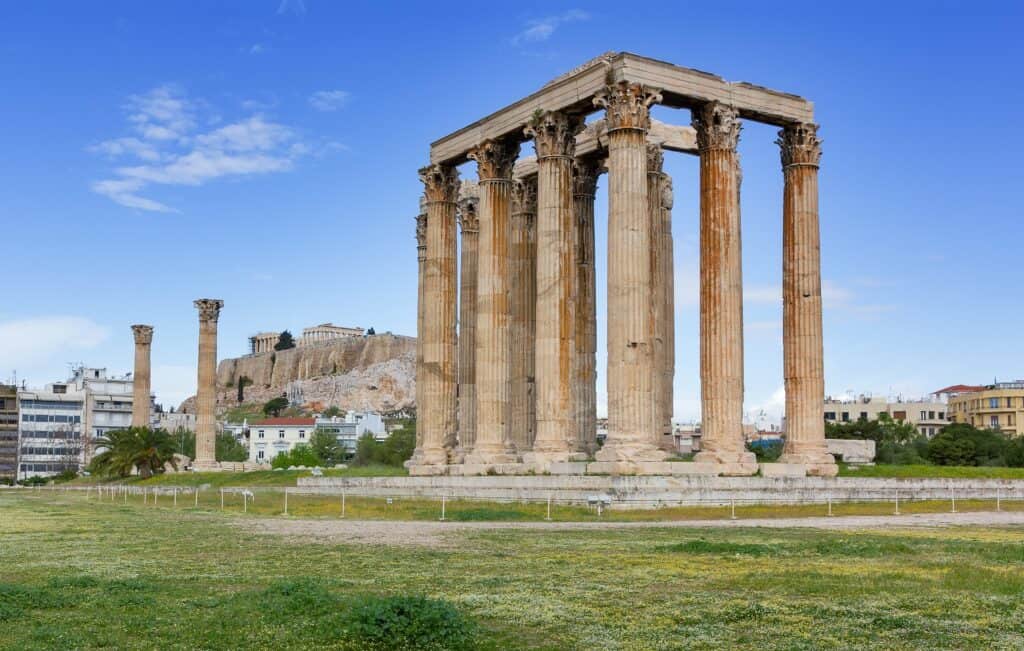
The Temple of Olympian Zeus, also called Olympieion, is located only 500 meters from the Acropolis of Athens. It was one of the largest and most important temples of ancient Greece. From the excavations and remains, you can guess what the temple was like in ancient times.
The construction of the Olympieion of Greece began as early as 550 BC but was not completed until the reign of Emperor Hadrian in the 2nd century A.D.
The building material used for the temple was Pentelic marble – a historically precious type of marble, of which many other ancient buildings in Athens are made.
The imposing temple complex made of Pentelic marble was 110 meters long and 43 meters wide. It is believed that the temple was largely destroyed by an earthquake in the Middle Ages.
Of the 104 massive columns, 15 columns remain today as a reminder of its former glory. It would be a waste to make it to Athens without visiting the Olympieion of Greece; the majestic building will blow you away with its beauty.
6-Byzantine Museum
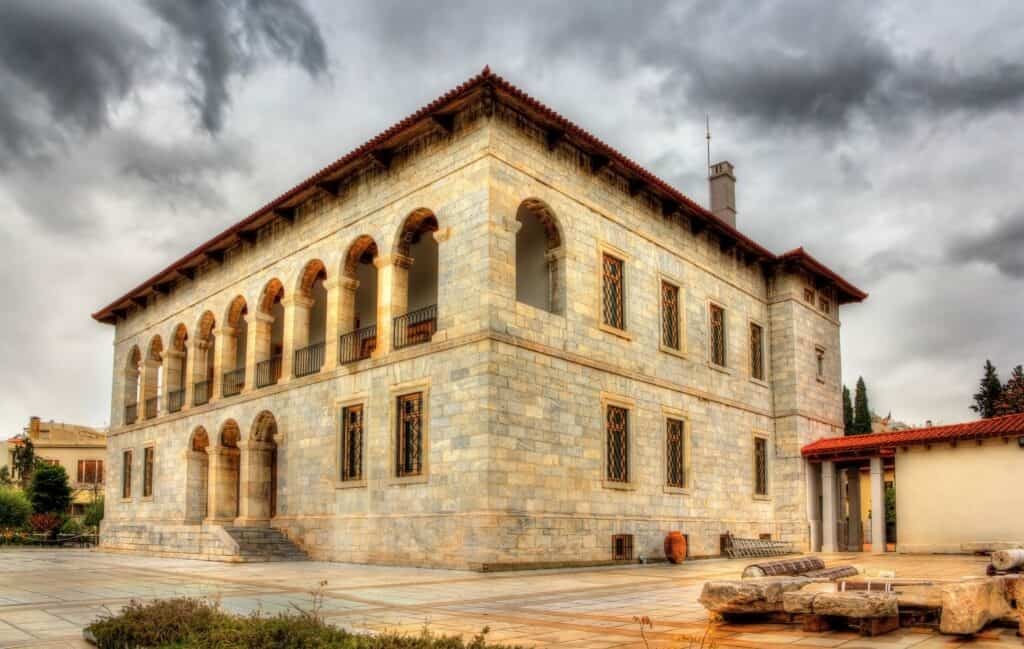
Greece is a country with a history of great magnitude. The country has gone through many eras; an important one of those eras was the age when Greece was part of the Byzantine Empire.
During this period, the Christian Orthodox Church had significant influence, and this is exactly what you can see in the various exhibits of the Byzantine Museum.
The exhibition of Byzantine art is located at Villa Ilissia, where a French duchess lived at that time. The permanent exhibition shows you ancient icons and many other impressive exhibits, such as the magnificent Krategos-Mytilene Treasure.
We recommend planning enough time to visit the museum because there is a lot to see and learn here; there are about 25,000 exhibits waiting.
We also recommend ending your tour at the museum with a meal on the terrace of the museum’s restaurant; it would be one of the most memorable meals of your life.
7-National Archaeological Museum
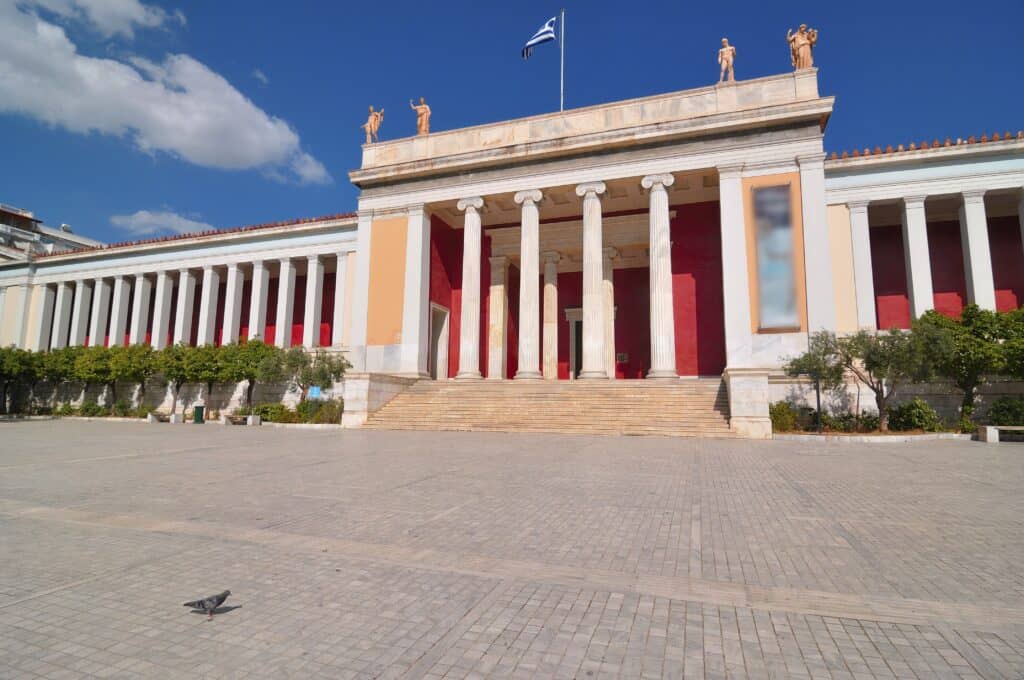
Museums are always popular attractions on a city break, and the Archaeological Museum in Athens is no exception. The National Archaeological Museum is the largest and most important museum in all of Greece.
It has an extraordinary collection of artifacts and works of art from the Neolithic to the Roman period. There is a permanent exhibition and special exhibitions throughout the year, for which three rooms in the building are reserved.
In the permanent exhibition, a total of 49 rooms await you where you can marvel at numerous objects from the most diverse periods and regions of Greece.
The following departments are the most visited in the museum in Athens: Prehistoric Collection, Sculpture, Bronze, Vases and Small Art, Jewelry, Glass Collection, and some other collections of historical pieces.
In the National Archaeological Museum, there is even a small section dedicated to Egyptian art. You can spend a lot of time in this wonderful museum and even those who are not familiar with art or ancient Greek time will enjoy their trip
Don’t miss the chance to marvel at five thousand years of history at the National Archaeological Museum.
8-Syntagma Square
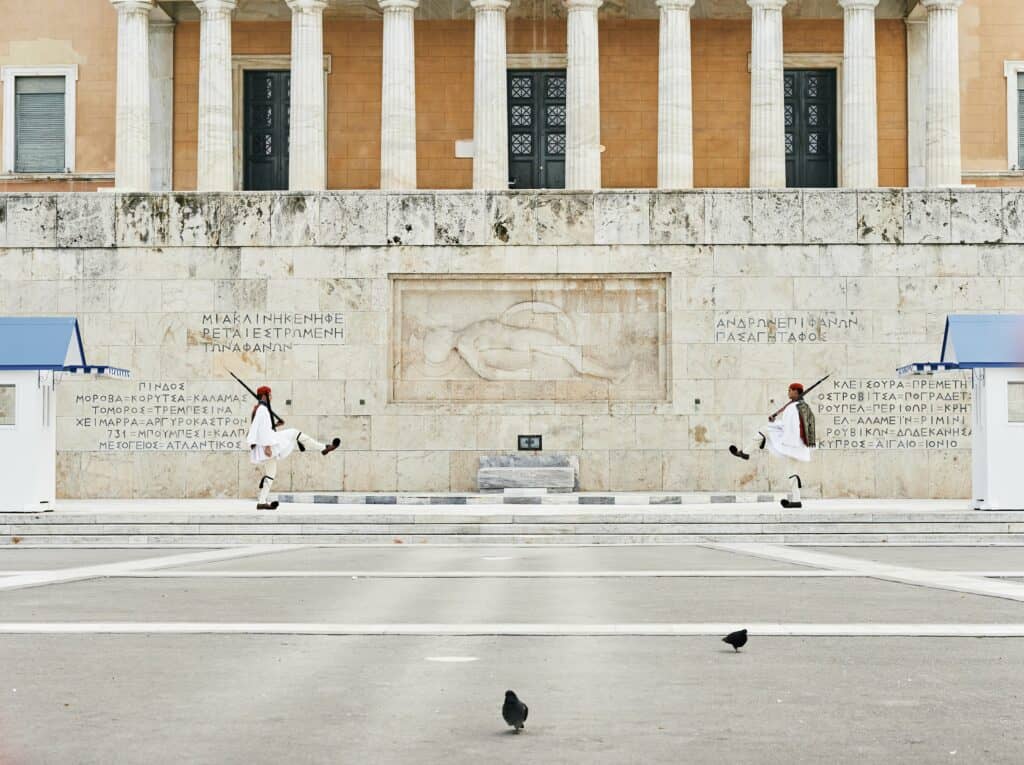
In the heart of the city, there is one of the most important sights of Athens: Syntagma Square. Syntagma Square (Constitution Square) is the central square of Athens and a popular meeting place for both tourists and locals.
It also hosts various events, such as the Athens Christmas Market. The square got its name when King Otto announced his approval of the constitutional monarchy as a result of an uprising.
The square is where the current Parliament building is located in a building that used to serve as the royal palace until 1910. In front of it is the Tomb of the Unknown Soldier, which is permanently guarded by the members of the former Royal Guard, the so-called Evzones.
Ermou Street, one of the main shopping streets in Athens, also begins here, where numerous designer stores, as well as more affordable stores, are lined up. If you are in a shopping mood, Ermou Street is the place to be.
We recommend ending your tour at the square by heading to Ermou street for some shopping…… Some sightseeing and shopping, does it get any better than that!
9-Plaka
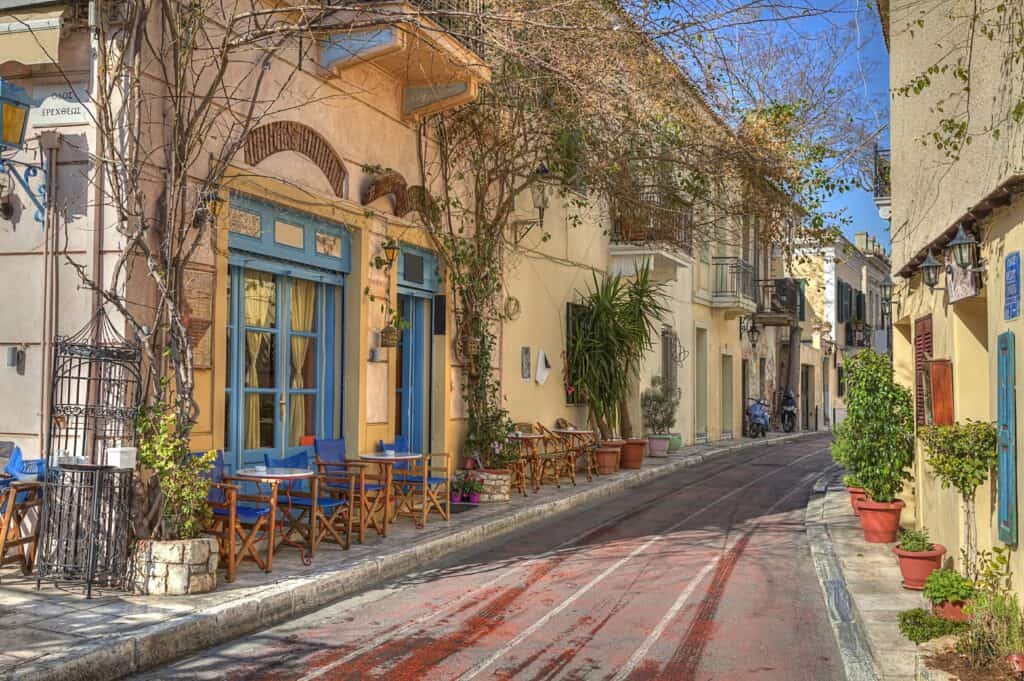
If you want to see one of the most historic and vital parts of Athens, then you have to go to Plaka. In the so-called quarter of the gods, you can stroll through the picturesque alleys, buy something or two at an auction, or just sit down in one of the cute cafes and rest your legs.
Plaka is filled with restored townhouses from the 19th century, and the Byzantine chapel of Agios Nikolaos Ragavas is also worth seeing. Finish your day after checking out Plaka in a cozy restaurant with a view of the Acropolis overlooking the district and indulge in Greek delicacies.
In Plaka, there are great souvenir stores where you can buy a souvenir for the ones back home. In the many boutiques, you can stock up on some new clothes. In the evening, it gets crowded in Plaka; locals and tourists come here to enjoy a glass of Greek wine on warm summer evenings.
10-Monastiraki
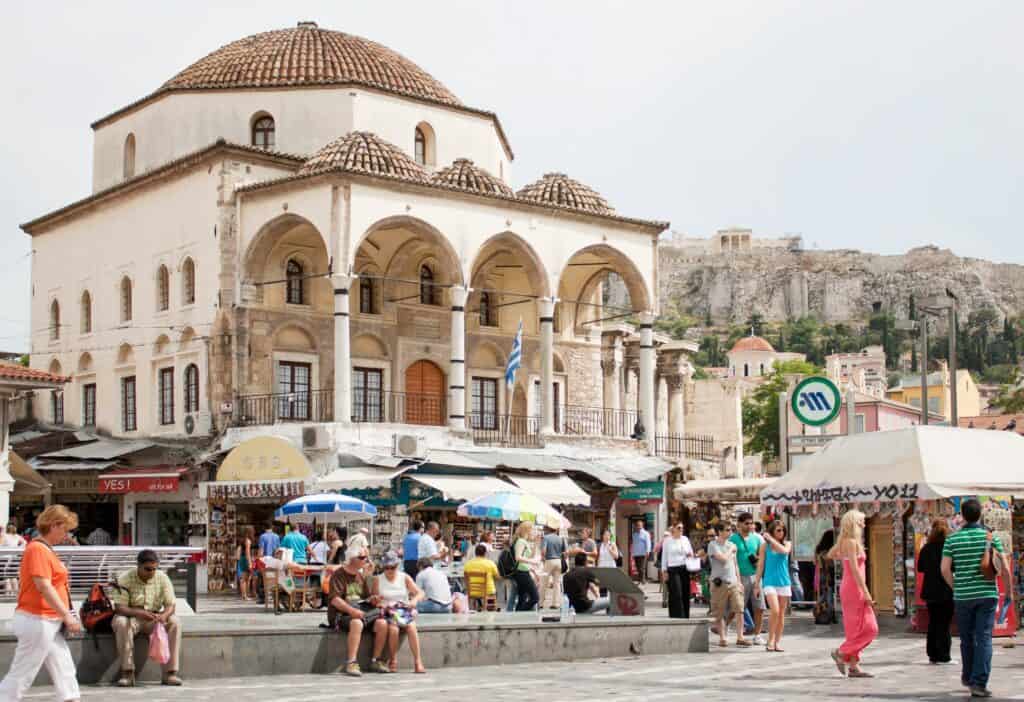
Monastiraki Square is the central square of Plaka. Everything comes and goes here, as there is a metro station here. Monastiraki is a part of Plaka and the flea market district of the city.
Here you can find antiques, leather clothes, and the latest sneakers at low prices in permanent stores. It seems more like a bit of a bazaar.
Monastiraki is one of the most popular shopping districts in Athens. Many narrow streets branch off from the large Monastiraki Square. Every Sunday, a lively flea market takes place in the immediate vicinity.
The square also includes some sites that are worth visiting, such as the Pantanassa Church with its beautiful decorations inside, as well as the Tzistarakis Mosque. The ruins of Hadrian’s Library, built by the Roman emperor Hadrian, are also worth a visit.
Since shopping makes us hungry, we recommend going to one of the cafes and restaurants in the square; there is something for everyone here. Directly on one of the corners of the square is the tavern Bairaktaris, which offers many typical dishes from Greek cuisine since 1879.
In Monastiraki, there is always something new to discover, even quiet winding alleys. The whole district is traffic-calmed, which is, of course, ideal for strolling.
11-Hadrian’s Library: Cultural Center of Emperor Hadrian
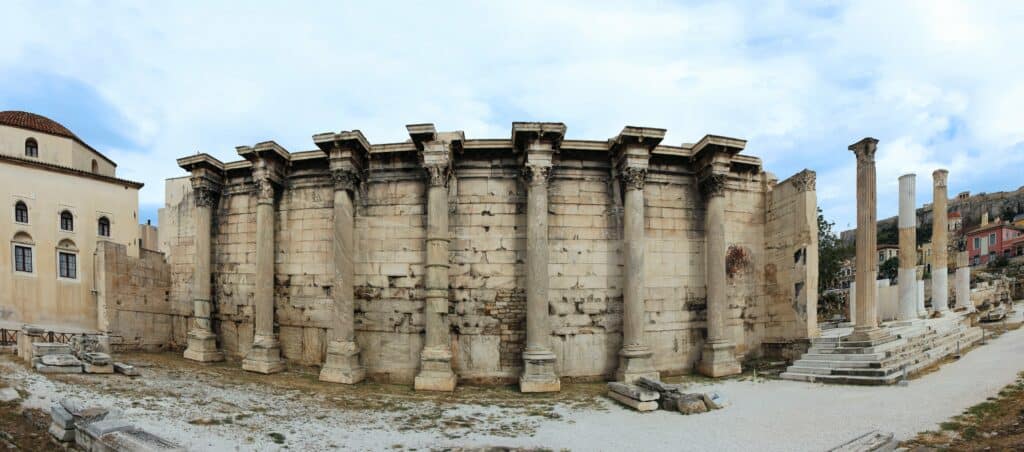
Hadrian’s Library was more of a cultural complex than “just” a library. The Roman emperor Hadrian was an outspoken philhellene and donated a large library to the city of Athens in the 2nd century A.D.
The building is almost as large as the entire Roman Agora. The inner courtyard covers an area of 100 × 70 meters and is surrounded by a peristyle.
It was not actually a library as we know it today, but rather a cultural complex with lecture halls, a transcription room, a library hall, and an odeon. The ruins of Hadrian’s Library are located very close to the modern Monastiraki Square.
In the area of Hadrian’s Library lives a large number of Greek tortoises (Testudo hermanni). The tortoises seem to have found an ideal habitat here. Tortoises live much longer compared to humans.
However, the destruction of their habitats and their popularity as pets has greatly endangered the population of tortoises. It is also threatened in Greece; however, it can be easily observed in the Kerameikos area.
12-Areopagus and Pnyx Hill with Philopappos Monument
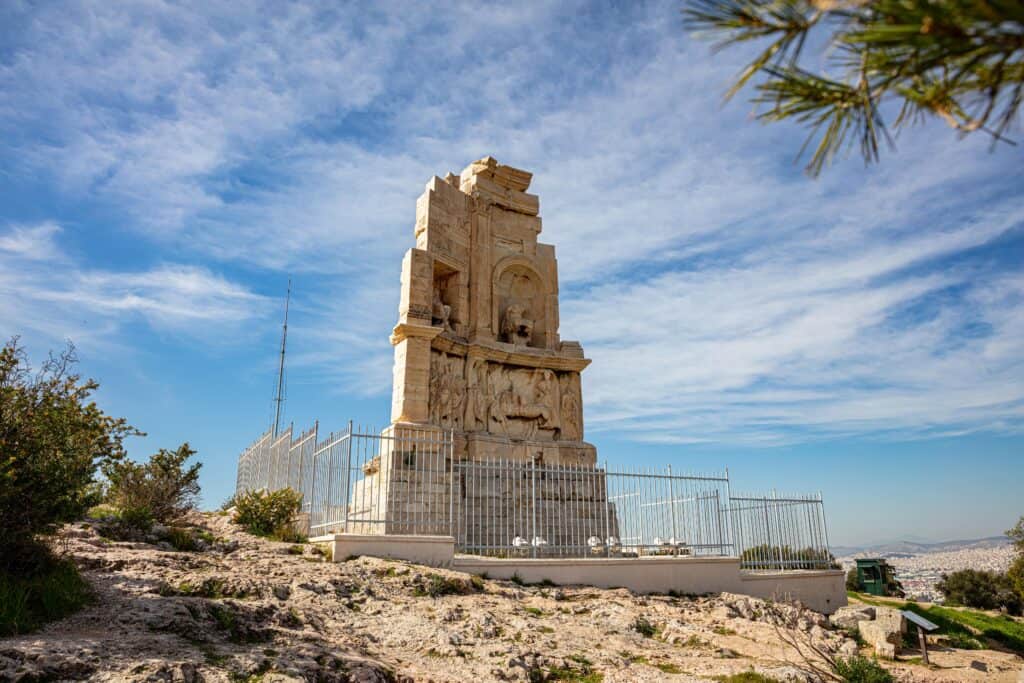
Near the Acropolis of Athens is the Areopagus rock, where once stood the courthouse of the ancient city. Legend has it that on the Areopagus, the Apostle Paul preached a sermon to the citizens of Athens.
The hill of Nymphs and Philopappos runs west of the Acropolis rock; here lies the Pnyx. It was the place where the ancient popular assemblies were held.
Members that came here were all free citizens of Athens, making the Pnyx the cradle of democracy in ancient times. Since the 4th century B.C., the members met ten times a year on the Pnyx to listen to speakers, but mainly to make political decisions.
Philopappos Hill was named after a monument on the hilltop that was built in honor of the Roman senator Julius Antiochus Philopappos. Philopappos lived for a long time in Athens, where he was revered as a great patron.
The site offers you a beautiful view of the sea and the Acropolis. In spring, the hill is covered in a fragrant sea of flowers and is a popular destination for excursions.
On the way to the top of Philopappos Hill, you will pass directly by the delightful church of Agios Dimitrios Loumbardiaris. It is said to have been built in the 16th century, but if you look closely at its walls, you will see that it is certainly several centuries older.
There is a legend about Agios Dimitrios saying that the Turkish commander of Athens ordered in 1645, on the feast day of St. Dimitrios, to bombard the church with cannons. The fire was to be opened from the Acropolis.
At the same time, a storm was approaching, and after a lightning strike in the Propylaea, the stored powder exploded. As a result, the church of St. Dimitrios (almost) miraculously escaped.
Right behind the church, there is an idyllic and shady garden cafe. Here it is worth having a coffee or light refreshment before continuing the climb to the Philopappos Monument and Pnyx Hill.
13-Let’s Eat!
The Greek cuisine is very diverse, and there is so much delicious food to try while in Athens. Try some of the famous dishes like the popular Pita Gyros, Souvlaki, Bifteki, and you can’t not try the fish! We recommend Dorade or grilled sardines…… So yummy!
A popular appetizer is dolmadakia, which are vine leaves stuffed with rice. Another very tasty dish is the moussaka, eggplant, minced meat casserole, and pastitsio, a casserole dish with pasta.
Of course, vegetarians don’t have to go hungry here, there are so many good vegetarian dishes too, like Gemista (vegetables stuffed with rice, typically tomatoes or peppers) and Briam (oven vegetables served with feta) are recommended.
Athens is one of those cities that you fall under its spell immediately. Whether you choose to follow the footsteps of ancient Greece, which can be found just about every corner or you are there for the great food and mesmerizing scenery, the Greek capital has many amazing things to do and places to visit.


